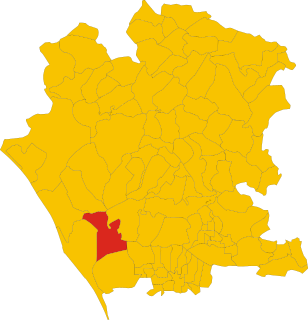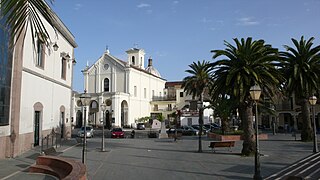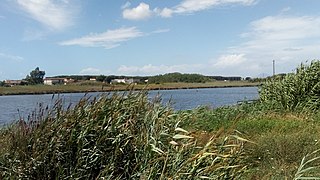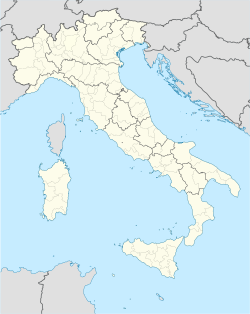
The Province of Caserta is a province in the Campania region of southern Italy. Its capital is the city of Caserta, situated about 36 kilometres (22 mi) by road north of Naples. The province has an area of 2,651.35 square kilometres (1,023.69 sq mi), and a total population of 924,414 as of 2016. The Palace of Caserta is located near to the city, a former royal residence which was constructed for the Bourbon kings of Naples. It was the largest palace and one of the largest buildings erected in Europe during the 18th century. In 1997, the palace was designated a UNESCO World Heritage Site.

Caserta is the capital of the province of Caserta in the Campania region of Italy. It is an important agricultural, commercial and industrial comune and city. Caserta is located on the edge of the Campanian plain at the foot of the Campanian Subapennine mountain range. The city is best known for the Royal Palace of Caserta.

Giugliano in Campania[dʒuʎˈʎaːno iŋ kamˈpaːnja], also known simply as Giugliano, is a city and comune in the Metropolitan City of Naples, Campania, Italy. As of 2017, it had some 124,000 inhabitants, making it the most populated Italian city that is not a provincial capital.

Greci is an Arbëreshë town and comune in the province of Avellino, Campania, Italy, located about 100 km northeast of Naples and about 50 km southwest of Foggia. It is a mountain agricultural village lying astride the Apennines and represents the only existing linguistic minority in Campania; Arbereshe people have settled in Greci since the 15th century.

Scheggino is a comune (municipality) in the Province of Perugia in the Italian region Umbria, located about 60 km southeast of Perugia. As of January 2020, it had a population of 464 and an area of 35.2 km².

Cancello e Arnone is a comune (municipality) in the Province of Caserta in the Italian region Campania, located about 35 kilometres (22 mi) northwest of Naples and about 25 kilometres (16 mi) west of Caserta.
Capriati a Volturno is a comune (municipality) in the Province of Caserta in the Italian region Campania, located about 70 km (43 mi) north of Naples and about 45 km (28 mi) northwest of Caserta.
Castel Campagnano is a comune (municipality) in the Province of Caserta in the Italian region Campania, located about 40 kilometres (25 mi) northeast of Naples and about 15 kilometres (9 mi) northeast of Caserta.

Castel Volturno is a comune (municipality) in the Province of Caserta in the Italian region Campania, located about 35 kilometres (22 mi) northwest of Naples and about 35 kilometres (22 mi) west of Caserta on the Volturno river. In 2010 Castel Volturno was inhabited by 25,000 locals and about 18,000 African refugees. Today (2019) there are still about 25,000 people, estimated two-thirds of them are immigrants.
Ciorlano is a comune (municipality) in the Province of Caserta in the Italian region Campania, located about 70 km (43 mi) north of Naples and about 45 km (28 mi) northwest of Caserta.
Valle di Maddaloni is a comune (municipality) of 2 661 inhabitants in the Province of Caserta in the Italian region Campania, located about 30 kilometres (19 mi) northeast of Naples and about 7 kilometres (4 mi) east of Caserta.
Villa Literno is a comune (municipality) in the Province of Caserta in the Italian region Campania, located about 25 kilometres (16 mi) northwest of Naples and about 25 kilometres (16 mi) west of Caserta.
Dugenta is a comune (municipality) in the Province of Benevento in the Italian region Campania, located about 35 kilometres (22 mi) northeast of Naples and about 30 kilometres (19 mi) west of Benevento.

The Battle of the Volturno refers to a series of military clashes between Giuseppe Garibaldi's volunteers and the troops of the Kingdom of Two Sicilies occurring around the river Volturno, between the cities of Capua and Caserta in northern Campania, in September and October 1860. The main battle took place on the 1 October 1860 between 30,000 Garibaldines and 25,000 Bourbon troops (Neapolitans).
Villaggio is an Italian word meaning "village". It may refer to:

Benevento railway station is the main station serving the city and comune of Benevento, in the region of Campania, southern Italy. Opened in 1868, it forms part of the Naples–Foggia railway, and is also a terminus of three secondary railways, linking Benevento with Campobasso, Avellino, and Cancello, respectively.

The nuraghe Seruci is an important archaeological site, located in the municipality of Gonnesa, in the Iglesiente region of Sardinia.

Lake Patria or Lago Patria is the largest coastal lake in Campania, with an area of 2 km². It is located in the municipality of Giugliano in Campania, in the frazione called precisely Lago Patria, and partly in the municipality of Castel Volturno, in the province of Caserta. It has a characteristic heart shape. It is the southernmost of the Pontine lakes.

The geography of Campania illustrates the geographical characteristics of Campania, a region of Italy.












